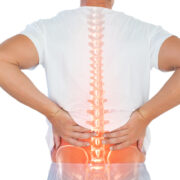The Connection Between Pelvic Misalignment and Back Pain
The Connection Between Pelvic Misalignment and Back Pain
By Bill Amos, PT
It’s my contention that most back pain emanates from the sacro-iliac (SI) joints. The sacrum is the triangle bone at the bottom of the spine between the 2 ilium bones which hold your guts in. Sir William Osler, M.D., who helped to bring Johns Hopkins Hospital to worldwide fame, was of the same opinion. The Fortin finger test derives from this same idea—to paraphrase, if your patients points at a spot on their back and says it hurts there, and it’s within 1 cm of the SI joint, then the pain is coming from the SI joint.
The SI joints are designed more for support than movement. They are maintained by a great number of ligaments on the back side of the pelvis. They must hold the upper body in place on the pelvis and allow movement of the lower body as well. X-ray studies indicate no more than 2-6 degrees under normal conditions, which is next to nothing!
Under less than optimal conditions, the pelvis can be pushed out of alignment into a formation known generally as an “obliquity”, or out of position. This means one or more of the 3 pelvic bones shift in any combination of 3 dimensions: twist, drop, rise, flare in or flare out.
In my experience, true sacral problems are only about 1 in 100. I have found much more success in correcting the iliac obliquity. This also seems to relieve a great deal of pain and movement limitation throughout the body globally.
I have also found it to be nearly universal for my patients to have a pelvic obliquity despite the location of their complaint. And I have found it really doesn’t take much work to make a huge difference (that is reduction) in pain levels for my patients. From headaches to hammer toes, correcting, or at least improving, the obliquity also reduces the primary complaints they have.
The pelvis underlies the spine and core muscles. If the pelvis is not square, or close to square, everything else is thrown out of alignment, placing more stress throughout the body. Wherever the stress is highest, the sensations of discomfort and eventually pain will occur. I think of that as the weakest link in the chain. That link could be anywhere in the body, including the rest of the spine, but that’s a story for another time.
* * *
If you are struggling with back pain or other joint pain, please contact our office to discuss further with a free 20-minute consultation: 301-881-2898 or email doctorhelena@gmail.com. Photo credit: © Wavebreakmedia Ltd | Dreamstime.com



